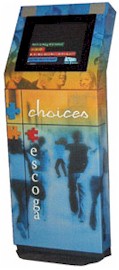News
The Tobacco Prevention Portal
February 29, 2004
 |
This past January, the director of the Centers for Disease Control and Prevention (CDC), Dr. Julie Louise Gerberding, put out a statement marking the 40th anniversary of the inaugural Surgeon General's report on smoking and health. The statement reported Adult smoking rates have been cut nearly in half between 1965 and 2001, from 42.4 percent to 22.8 percent, and per capita consumption of tobacco products has fallen more than half, from 4,345 cigarettes in 1963 to 1,979 cigarettes in 2002. "But, tragically, smoking remains the leading preventable cause of death and disease in the United States, claiming the lives of more than 440,000 Americans each year," noted Gerberding.
The good news from the statement is that we know what works to curb tobacco use: comprehensive programs combining school, healthcare, community, media, and policy efforts. Gerberding drove home the statement by saying, "We must now commit ourselves to implementing in every state and locality these proven approaches to prevent youth from starting to smoke, to help smokers to quit, to protect people from secondhand smoke, and to eliminate tobacco-related disparities. "
Taking the importance to start the education of young and impressionable youth seriously has now entered a new phase. Especially when the figures become apparent; from 2000 to 2002, there were no significant declines in smoking rates for middle school students in all racial/ethnic groups. A new approach in the form of an interactive kiosk has been recruited to help in the effort.
St. Andrew Development, Inc., a health and human services company, has worked with many health-related kiosk projects over the years. Company President Frank McKee is an avid athlete and when presented with the chance to use kiosk technology to educate children about the use of tobacco, he jumped at the opportunity. The resulting product, the Tobacco Prevention Portal, was built with the purpose of meeting one of the greatest challenges faced by health educators — delivering understandable health information to kids.
 |
These are the main pages in English and Spanish. All navigation into the taxonomy of the kiosk system begins here. |
About the kiosk system
Information in the Tobacco Prevention Portal flows directly to users in a variety of effective ways. Presented in English and Spanish, content can be read, listened to and seen in video form. This multi-media approach to delivering health information to kids assures that the greatest number of users receive and understand the facts about tobacco use.
The Tobacco Prevention Portal functions as a fully self-contained knowledge station dispensing credible information on the perils of tobacco use. It resides in a stand-alone enclosure with a touch-activated computer screen. The system uses audio speakers to provide narration to enhance text and support video. Sponsors can add customized content describing any special programs they have to support tobacco awareness or other health related initiatives.
St. Andrew Development Inc. is collaborating with several leaders in the field of smoking prevention and kids. The American Lung Association of Pennsylvania, the BUSTED program, The Institute for Healthy Communities and Learning Tek are all playing active roles in helping develop content.
The first deployment of the Tobacco Prevention Portal kiosk occurred in the Pittsburgh, Philadelphia, and Harrisburg late last year. "We've gotten really positive feedback and the kids are going crazy for it. We've had over 1,300 users in a three day period," noted McKee.
Research has shown that one of the most effective means to educate kids is to show them that they're mortal. "The kiosk system is showing them that the tobacco companies intend to take advantage of them," pointed out McKee.
 |
In the "We own you ... " video, Zombie represents the tobacco companies and emphasizes that they control kids' lives through addiction. |
At the heart of the kiosk
"The Tobacco Prevention Portal gets positive reviews because we pay close attention to how our users react to the information we deliver," stated McKee. St. Andrew Development took what their users — the kids in this case — had to say very seriously. The company gathered focus groups composed of kids to review the kiosk while they were developing it. From color selection to videos and narration, St. Andrew listened to what the kids had to say in order to be certain when other middle school students would use the Tobacco Prevention Portal, health educators could be sure that the powerful message of the perils of smoking and tobacco use is getting through loud and clear.
The kiosk, now deployed by sponsors, has been a new method to reach the children in a more measurable way. The kiosk uses a tracking process that collects information on metrics that can be used by sponsors to measure results. It is also capable of keeping the content/information on the kiosk current and relevant. Sponsors and educators win. But, most of all, the kids win because they get information that they can understand and act upon.
Teen Prevalence of Tobacco Use:
- Every day more than 4,000 young people try cigarettes for the first time.
- Tobacco use among high school students declined significantly from 34.5 percent in 2000 to 28.4 percent in 2002, continuing a downward national trend since 1997.
- Cigarette smoking, the most common use of tobacco among high school students, declined significantly from 28 percent in 2000 to 22.9 percent in 2002. There were no differences by gender for cigarette smoking among high school students in 2002.
- From 2000 to 2002, among middle school students, there was no significant decline in use of tobacco products overall (13.3 percent) or for any individual tobacco product.
- Among middle school students, males were more likely than females to use all of the tobacco products, except for cigarettes (10.2 percent and 10 percent respectively).
- Cigarettes (10.1 percent) were the most commonly used type of tobacco among middle school students in 2002.
- From 2000 to 2002, there were no significant declines in smoking rates for middle school students in all racial/ethnic groups.
Researchwww.cdc.govwww.standrew.com
Originally published in the Mar/Apr 2004 issue ofKiosk magazine.







